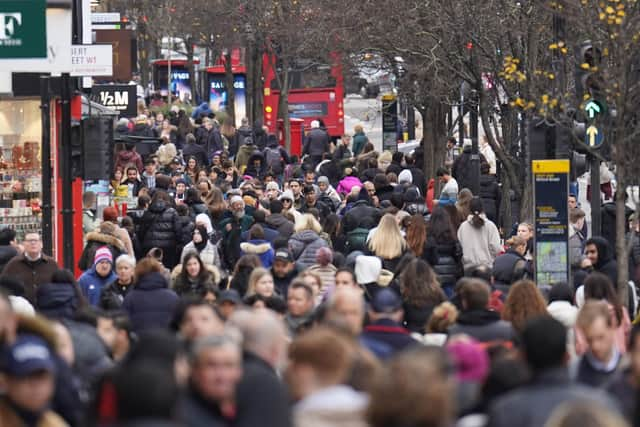UK population climbs to new estimate of 67.6 million, with Northern Ireland population rising 5.3% since mid-2011
and live on Freeview channel 276
England saw the biggest percentage increase across the period, with its population jumping by 7.5% – the equivalent of 4.0 million.
Northern Ireland saw the next highest increase at 5.3%, or an additional 96,225 people, followed by Scotland (2.8% or 147,800 people) and Wales (2.2% or 67,882 people).
Advertisement
Hide AdAdvertisement
Hide AdThe population estimates of the four home nations in mid-2022 were as follows:
England – 57,106,000;
Scotland – 5,448,000;
Wales – 3,132,000;
Northern Ireland – 1,911,000;


UK total – 67,596,000.
The figures have been published by the Office for National Statistics (ONS) and are the first UK-wide estimates for mid-2022, making them the most up-to-date snapshot of the country’s population.
They show the median average age of people in the UK in the year to June 2022 was 40.7 years, up from 39.6 years in the year to June 2011.
All four nations now have a median age in the 40s, with Scotland recording the oldest, at 43.0 years, followed by Wales (42.9), England (40.5) and Northern Ireland (40.0).
Advertisement
Hide AdAdvertisement
Hide AdPopulation estimates for Scotland for the years before 2022 have yet to be revised to account for the latest Census, which took place here in March 2022, a year later than in the rest of the UK.
This means there are currently no comparable UK-wide estimates for the period 2012 to 2021 – and is why the new figures are compared with 2011, when the Census took place in all four nations on the same day.
A full set of updated population estimates for the UK will be published after Scotland has revised its data for 2012-21, the ONS said.
The figures for England and Wales were first published in November 2023 and showed the combined population of the two nations grew by an estimated 1% in the 12 months to June 2022, the fastest rate for 60 years.
Advertisement
Hide AdAdvertisement
Hide AdThe increase was driven mostly by international migration, rather than natural change – unlike the baby boom which fuelled the growth in the early 1960s.
The new ONS data released on Tuesday shows sharp differences across the UK in the age structure of the local population.
Just over a third (33.8%) of people estimated to be living in North Norfolk in mid-2022 were aged 65 and over – the highest proportion for this age group anywhere in the country.
Rother in East Sussex (32.6%), East Lindsey in Lincolnshire (30.6%) and Dorset (30.0%) had the next highest levels.
Advertisement
Hide AdAdvertisement
Hide AdBy contrast, just 5.6% of people in the London Borough of Tower Hamlets were 65 and over, the lowest figure anywhere in the UK, followed by the nearby boroughs of Newham (7.3%), Hackney (8.1%) and Southwark (8.6%).
At the other end of the age spectrum, the London Borough of Barking & Dagenham had the highest proportion of people aged 15 or under in mid-2022, at 26.0% of its population, followed by Slough in Berkshire (25.0%), Luton in Bedfordshire (23.3%) and Mid-Ulster in Northern Ireland (23.0%).
The City of London had the lowest percentage (4.9%), followed by Westminster (12.6%), North Norfolk (13.3%) and Kensington & Chelsea (13.7%).
The data tends to show “higher proportions of younger people in more urban areas and higher proportions of older populations in more rural areas”, the ONS said.
Advertisement
Hide AdAdvertisement
Hide AdThis trend is reflected in the locations with the highest and lowest median age in mid-2022.
North Norfolk again tops the list, at 55.3 years, with Rother (53.8), East Lindsey (53.3) and Derbyshire Dales (52.5) close behind.
Tower Hamlets has the lowest median age (30.5), followed by locations with large student populations: Manchester (30.7), Nottingham (31.0), Oxford (31.7) and Cambridge (31.8).